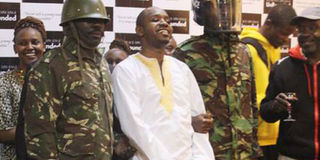The life of Boniface Mwangi is one of exceptional courage

Boniface Mwangi during the launch of his book 'Unbounded' on November 26. PHOTO | MARGARETTA WA GACHERU
What you need to know:
- He decided that it was not enough to tell Kenyans’ stories through images; he wanted to expose the injustices that lay behind the images.
- One of the most disturbing images in the book is of a hawker laughing over the body of a police officer.
By the time Boniface Mwangi was in his early 20s, he had witnessed and experienced more cruelty than most of us experience in a lifetime.
The photojournalist was on the frontlines when violence erupted in many parts of the country after the 2007 elections.
His gruesome images of the violence shocked Kenyans and the world, and became the subject of a book and an exhibition titled Kenya Burning.
The images are not for the faint-hearted: one shows a severed hand with the watch on the wrist still ticking.
Witnessing the post-election violence first-hand was a turning point for the young photographer.
He decided that it was not enough to tell Kenyans’ stories through images; he wanted to expose the injustices that lay behind the images.
He decided to use his photography to paint a larger picture of what being Kenyan means to people who have only known poverty, hunger, and State-inflicted terror.
Some of these Kenyans’ stories — including his own — have now been captured in his new book, Unbounded.
Boniface comes from a family of Mau Mau fighters who were betrayed by the so-called “loyalists” who grabbed the land the freedom fighters fought so hard for and relegated people like his grandfather to poverty.
EXPELLED
In the book, you will find up close and personal images of Boniface as a young boy with his mother, who struggled to raise her children and also succumbed to a cultish religion — as so many desperate Kenyans did then and still do when confronted with hardship or adversity.
“During that time, my mum would disappear for weeks and I would later learn that she was going away to fast and pray for President Moi to die,” he writes.
Boniface’s mother died of cancer at the relatively young age of 48; her religion forbade her from going to hospital for treatment.
Childhood rebelliousness resulted in Boniface being admitted to various juvenile remand homes and correctional institutions — the so-called approved schools — where living conditions are dire and children are routinely mistreated by teachers and sexually molested by other children.
If Boniface was not Boniface these “schools of hard knocks” might have lured him into criminality, but he used his experiences there to fight for justice.
He convinced his mother to buy him a camera so he could secretly photograph the inhuman treatment of children in one such school.
He showed the photos to the then Minister of Home Affairs, Shariff Nassir.
Ironically, but not surprisingly, the evidence he presented to the minister did not lead to an official investigation of the school — it got Boniface expelled.
You could say that this incident was the beginning of his career as a photojournalist-cum-activist.
Boniface went on to work for the Standard newspaper, where his various assignments gave him an opportunity to photograph Nairobi’s dark underbelly: young boys scavenging for food at the Dandora dumpsite along with pigs, homeless people sleeping on the streets, hawkers and prostitutes being harassed by city askaris, police executions of suspected criminals, and inmates’ living conditions in prison.
One of the most disturbing images in the book is of a hawker laughing over the body of a police officer.
POWER OF HARDSHIPS
Occasionally, Boniface would also be assigned to cover socialites, which is how he managed to take pictures of so-called “celebrities” at a party hosted by the infamous Artur brothers, who were believed to be international drug traffickers, but who somehow managed to get State protection under Mwai Kibaki’s first administration.
Unbounded also records police brutality inflicted on suspected Mungiki members in Nairobi’s slums.
One image shows police officers laughing as a police dog tears into a young man’s trousers.
Another shows women and men in Mathare lying on the ground as a plainclothes police officer walks on them.
The most bloody images in the book are undoubtedly those of the victims of the post-election violence: a mob killing a matatu driver in Huruma and robbing his passengers, houses and shops burning, dead bodies lying on the street, burnt corpses in a Naivasha morgue, and many more.
The book shows that Kenya still has a long way to go before it becomes a humane and just society.
What it also shows is that while hardship and injustices can lead some people to crime or cynicism, they can also be catalysts for acts of exceptional courage.





